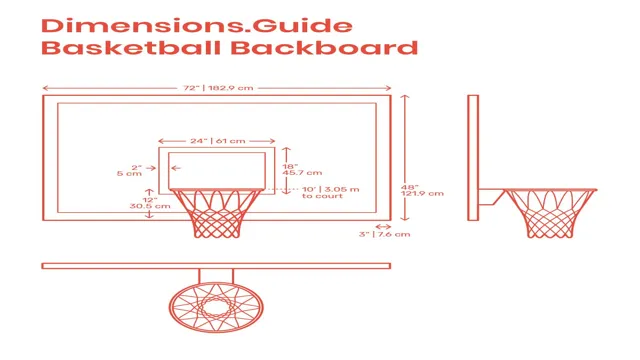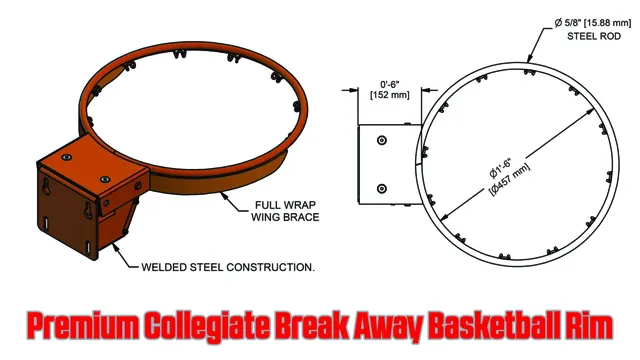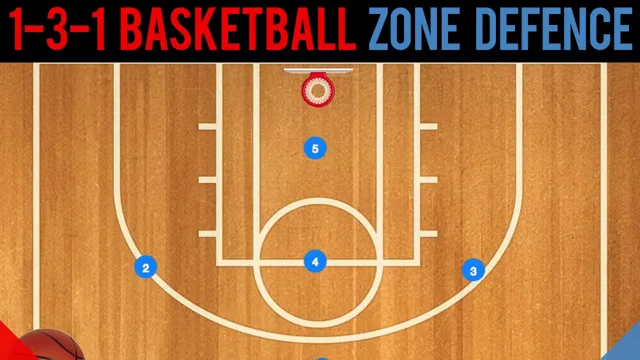Basketball is a thrilling sport that requires skill, strategy, and a keen eye for the basket. One of the most crucial components of any basketball game is the hoop or the rim. Without it, the sport simply wouldn’t exist.
However, as with most things, not all rims are created equal. There are various sizes and dimensions that need to be taken into consideration when setting up a basketball hoop. It can be confusing, especially for new basketball enthusiasts, to understand the different measurements and how they relate to the game.
That’s why in this blog, we’ll take an in-depth look at basketball rim dimensions and their impact on the game. Whether you’re a seasoned player or a beginner, this guide will provide you with all the information you need to know about basketball rim dimensions, so you can make the most out of your game.
Regulation Size
When it comes to basketball, the rim dimensions are crucial to creating a fair and competitive game. A regulation size basketball rim has a diameter of 18 inches and is positioned exactly 10 feet above the ground. This size has been standard since the beginning of the modern game in the late 1800s and is used in all official competitions.
Maintaining consistency in basketball rim dimensions ensures that every player has an equal opportunity to score, whether they’re playing in a high school gym or in a professional arena. It also allows players to practice their skills and develop muscle memory that they can carry over to any court they play on. So, whether you’re shooting hoops for fun or aiming to be a star athlete, it’s important to understand the significance of regulation size basketball rim dimensions and how they affect the game.
Standard measurements for official games
When it comes to official games, the size of the equipment and playing field can make all the difference. Standard measurements are in place not just to ensure a level playing field, but also for safety reasons. In the case of soccer, the regulation size for a game ball is between 27 and 28 inches in circumference.
The height of a regulation soccer goal is 8 feet, while the width measures 24 feet. In basketball, the regulation size for a ball is 25 inches in circumference, with a hoop height of 10 feet.
Tennis is another sport with strict regulations, requiring a court length of 78 feet and a width of 27 feet for singles matches. These measurements may seem arbitrary, but they play a crucial role in creating a fair and safe playing environment for athletes.

Diameter of 18 inches
When it comes to playing sports, having the right equipment is crucial for success. In the case of basketball, the size and dimensions of the ball can greatly impact the game. One of the most important factors to consider is the diameter of the ball, with regulation size being 18 inches.
This size allows for a balance between control and handling, making it ideal for players of all levels. However, it’s important to note that different age groups and leagues may have different regulations when it comes to ball size. It’s always best to double-check with your coach or league officials to ensure you have the right size ball for your game.
Whether you’re playing a casual pick-up game or competing in a championship match, choosing the correct ball size can make all the difference in your performance and enjoyment of the sport.
Height of 10 feet from the floor
When it comes to basketball, one of the most important regulations is the height of the hoop. The standard height of a basketball hoop is 10 feet from the floor, both for professional and amateur games. This regulation size ensures that all players face the same level of challenge when it comes to shooting, dribbling, and dunking.
While some may argue that this height is too difficult for younger or shorter players, it’s important to remember that it provides a fair playing field for all. Additionally, it gives players a goal to strive for and motivates them to improve their skills and physical fitness. If the hoop were lower, it could also affect the game in other ways.
Players may rely too heavily on dunking, for example, and overshoot the ball when attempting a regular lay-up or shot from a distance. Additionally, lowering the hoop could lead to a higher risk of injuries, as players may be more likely to collide or trip over each other while attempting to get the ball. Overall, the regulation size of a basketball hoop at 10 feet from the floor is an important aspect of the sport.
It ensures a level playing field for all players and encourages individuals to improve their skills and work towards a common goal. Whether you’re an aspiring pro or a casual player, it’s an essential part of any basketball experience.
Alternative Sizes
Basketball rim dimensions can vary depending on the level of play and age of the players. The standard for most regulation basketball rims is 18 inches in diameter, but alternative sizes exist to accommodate younger or shorter players. For instance, youth basketball rims for players under 10 years old often have a diameter of only 16 inches, while college and professional rims can reach a diameter of up to 20 inches.
The height of the rim also varies significantly between age and level of play, with the standard regulation height being 10 feet. However, younger players may have rims at a height of 8 or 9 feet depending on their age and ability. Regardless of the size, the objective of scoring remains the same, and players must work to adjust their shooting technique and angle based on the rim dimensions they are playing with.
Variations for practice and recreational use
If you’re looking to mix up your practice or recreational tennis game, consider alternative sizes for your tennis court. While traditional tennis courts are typically 78 feet long and 36 feet wide, there are several variations available that can accommodate different playing styles or skill levels. One alternative size is a “short” court, which is 60 feet long and 21 feet wide, and is designed for younger players or beginners.
This court size can also be used to improve your footwork or practice specific shots, as the smaller court requires more agility and precision. Another option is a “mid” court, which is 62 feet long and 27 feet wide, and is popular for doubles matches. This size allows for more strategy and teamwork since players have less space to cover on the court.
Overall, tweaking the size of your tennis court can add a new level of excitement and challenge to your game, so don’t be afraid to experiment with different options.
Smaller diameters for youth and beginners
For young or beginner players, choosing the right diameter for your lacrosse stick is important. While a standard adult diameter is 0 inch, smaller diameters are available for those who need it.
For youth players, a 7/8-inch diameter may be more comfortable and manageable, while a 3/4-inch diameter may also be appropriate for beginners. These alternative sizes allow for greater control and ease of handling, which can help with skill development and overall enjoyment of the game. It’s important to choose a stick that is compatible with these smaller diameters, as not all sticks come in alternative sizes.
By considering the appropriate diameter for your age and skill level, you’ll be able to optimize your performance and enjoy the game even more.
Adjustable heights for different skill levels
Adjustable heights for different skill levels are a great way to ensure everyone can enjoy a game. Luckily, there are alternative sizes available on the market. For example, if you’re looking for a basketball hoop, you can find models that are adjustable to different heights.
This way, kids and adults of all skill levels can play together without anyone feeling left out. The same goes for other sports equipment like soccer goals or volleyball nets. By having alternative sizes available, you can ensure that everyone can have a good time and feel included.
So, the next time you’re looking to buy sports equipment, keep in mind that adjustable heights and alternative sizes are key to ensuring a positive experience for everyone involved.
Rim Components
When it comes to basketball rim dimensions, there are a few key components to consider. The first is the diameter of the rim itself, which is typically around 18 inches. However, some leagues or organizations may require slightly different dimensions, so it’s important to check the rules before purchasing a rim.
Another important component is the thickness of the rim, which can vary depending on the level of play. For professional and college-level games, the rim is typically around 5/8 of an inch thick, while for recreational or backyard hoops, a rim may be thinner and more lightweight. Finally, the materials used to construct the rim can also impact its performance and durability.
While many rims are made from steel, more expensive models may use materials like aluminum or even carbon fiber to provide additional strength and flexibility. Overall, it’s important to choose a rim that matches your level of play and meets any specific requirements or regulations.
Breakaway mechanisms and net attachment hardware
Rim components play a crucial role in the breakaway mechanisms and net attachment hardware used in basketball. These components include the rim, backboard, and net. The rim is typically made of steel and is attached to the backboard by braces.
The breakaway mechanism is responsible for allowing the rim to move slightly upon impact, reducing the risk of injury to players. The net, on the other hand, is made of nylon and is attached to the rim with hooks. It serves as a guide for the ball, making it easier for players to see if their shots have gone in or not.
When it comes to basketball equipment, rim components are often overlooked, but they are critical in ensuring player safety and the smooth flow of the game. If the rim, backboard, or net is not in good condition, it can affect the game’s dynamics and put players at risk of injury. Overall, investing in high-quality rim components is essential for any basketball court owner or player.
Materials and construction options
Rim components are necessary for the construction of various types of vehicles, such as bicycles and cars. These elements essentially form the outer edge of a wheel and help provide stability during motion. The materials used for rim components vary depending on the application, but some common options include aluminum, carbon fiber, and steel.
Aluminum is a widely used material for bicycle rims as it is lightweight, strong, and corrosion-resistant. Carbon fiber is also a popular option among high-performance bicycle riders, as it is even lighter than aluminum but more expensive. Steel rims, on the other hand, are commonly used in car construction due to their durability but can be heavy.
When constructing rims, there are different methods available, including welded, cast, and forged construction. Welded rims have a seam that can be a weak spot, while cast rims are made through a casting process, making them more uniform. Forged rims are created through the application of pressure on metal, resulting in a denser and stronger end product.
Ultimately, the materials and construction method used for rim components will impact the weight, performance, and longevity of the finished product.
Installation Requirements
When it comes to basketball rim dimensions, it’s important to not only focus on the size of the hoop itself, but also on the installation requirements. In order to properly install a basketball rim, you’ll need to make sure you have a sturdy support system in place. This usually means either attaching the rim to an existing backboard or installing a new backboard altogether.
The backboard should be made of a durable material, such as tempered glass or an acrylic composite. Additionally, you’ll need to consider the spacing and height of the rim. For regulation play, the rim should be 10 feet off the ground and the hoop should have a diameter of 18 inches.
However, if you’re installing a basketball rim for casual play, you can adjust the height and diameter to better fit your needs. Overall, by making sure you have the proper installation requirements in mind, you’ll be able to enjoy your basketball rim for years to come.
Mounting options and considerations for different playing surfaces
When it comes to mounting options for different playing surfaces, there are several installation requirements to consider. First and foremost, the surface must be sturdy enough to support the weight of the equipment and players. The mounting hardware must also be strong enough to withstand the constant movement and use that comes with playing a game.
Additionally, the height and placement of the equipment must comply with any relevant safety regulations. For outdoor surfaces, weather-resistant materials must be used to prevent rust and corrosion. It is also important to consider the surface itself – for example, mounting on concrete requires a different installation process than mounting on grass or dirt.
Ultimately, proper installation is crucial for ensuring the safety of players and the longevity of the equipment.
Conclusion
After diving into the world of basketball rim dimensions, one thing is clear: these rims are much more than just a circular piece of metal. From the proper size and height to the thickness of the net and backboard, every aspect of a basketball rim is carefully designed to create the perfect playing experience. So next time you’re on the court, take a moment to appreciate the intricacies of the rim and all the hard work that goes into making basketball the thrilling sport it is.
“
FAQs
What are the standard dimensions of a basketball rim?
The standard dimensions of a basketball rim are 18 inches in diameter and 10 feet above the ground.
What is the distance from the baseline to the center of the basketball rim?
The distance from the baseline to the center of the basketball rim is 4 feet.
Can the height of a basketball rim be adjusted?
Yes, the height of a basketball rim can be adjusted. The standard height is 10 feet but it can be lowered to accommodate younger players.
What is the diameter of a basketball rim’s net?
The diameter of a basketball rim’s net is between 15-18 inches.


